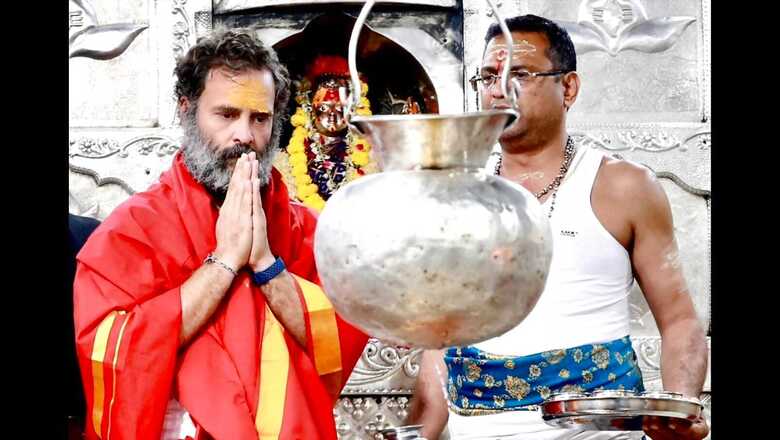
views
In the course of the Bharat Jodo Yatra, Rahul Gandhi has undertaken a ‘Temple Run’ reminiscent of his whirlwind tour of religious sites ahead of the 2017 Gujarat Assembly elections. The fresh foray into so-called ‘soft Hindutva’ is based on the premise that it undermines the BJP’s strategy of Hindu consolidation.
So, we see Rahul Gandhi draped in saffron, sitting cross-legged on the banks of Maa Narmada, with mala and mauli, turban and tika. Lacking exposure to the religio-cultural traditions of the subcontinent for the most part, Gandhi is a bit out of his comfort zone. His spiritual pursuits so far have been of the vipassana-in-Cambodia kind.
But the Gandhi scion is making brave attempts to ‘Hindu-ise’ himself. Temple visits are a visible part of that exercise, which stems from the Congress effort to reshape its secularist dogma, in tune with prevailing political currents. The result has been utter confusion. How do you trump the icon of Hindu nationalism, given the Congress’ legacy of Nehruvian agnosticism?
Gandhi’s Temple Run 1.0 involved visiting some 27 temples across Gujarat, from Ambaji and Akshardham to Unai Mata and Valinath. The party won in 18 of the ‘temple’ constituencies he visited, displacing the BJP in ten of them. Post-electoral analyses indicated that it was the Patidar agitation and agricultural distress, rather than temple-hopping, that helped the Congress improve its tally.
However, pleased by its apparent success in wooing the majority community, the grand old party reprised the effort to acquire a saffron tint in 2018. Ahead of the Karnataka Assembly elections, Gandhi made it a point to visit a number of temples — Chamundi in Mysuru, Malemahadeshwara in Chamarajanagar, Durgambika in Davangere and so on. He also met the heads of the powerful Lingayat mutts. But Karnataka’s dominant community chose to go with the BJP.
The Congress is hoping that its outreach to the majority community, in combination with 27 years of anti-incumbency, will improve its standing in Gujarat and prove the exit polls incorrect. On the Karnataka leg of his Bharat Jodo Yatra, the former Congress chief visited the Suttur Mutt to meet its head, Sri Shivarathri Deshikendra Mahaswamiji and paid homage at the Chamundeshwari and Srikanteshwara Swamy temples.
In Madhya Pradesh, he participated in an aarti at Omkareshwar and paid his respects at Ujjain’s famous Mahakal temple (he is a devotee of Lord Shiva, according to Rajasthan chief minister Ashok Gehlot). He also met the Jain seer Pragyaji Maharaj at his Tapobhumi ashram for 25 minutes. For good measure, he invited godman Namdeo ‘Computer Baba’ Tyagi to join him on his Bharat Jodo Yatra.
The purpose of Temple Run 2.0 is to craft a counter-narrative to the BJP, which can be summed up as ‘Hinduism vs Hindutva’. Gandhi, prompted by the Congress brains trust (Shashi Tharoor, Jairam Ramesh, P Chidambaram), is attempting to draw a distinction between ‘real’ Hindus who aspire to high ideals, and power-hungry ‘Hindutvawadis’ who owe allegiance to the RSS.
After decades of embracing Nehruvian secularism, pandering to Left-leaning liberals and demonising the Right wing, the Congress finally woke up to the altered political reality of Hindu consolidation. But the party’s efforts to distance itself from charges of minorityism and change its extreme ideological stance have been erratic. The mindset of the UPA years, during which Narendra Modi was a favourite target even as his stature grew with the success of the ‘Gujarat model’ and consecutive electoral victories, still persists.
Congress leaders have yet to shed their tendency to go overboard in asserting their secular credentials. Rajnandgaon mayor Hema Deshmukh, for instance, recently attracted flak for attending a mass conversion ceremony where an oath to repudiate Hindu gods was reportedly administered. Karnataka acting Congress chief Satish Jarkiholi courted controversy by describing the word ‘Hindu’ as Persian and with a ‘dirty’ meaning.
Gandhi himself sends mixed signals. For example, he chose to invite hijab-wearing girls to join him on his march, at a time when anti-hijab protesters in Iran are being killed or incarcerated. Nor did the Left-leaning individuals who joined his yatra add punch to Gandhi’s ‘Hindu’ stance.
So, while Gandhi’s attempt to tap into the mainstream majority sentiment will please a large section of his party workers, voters are unlikely to respond to his brand of ‘Hinduism lite’. They see the BJP — and Modi — as the real thing. The intellectual distinction that Gandhi is trying to make between the Congress and BJP versions of Hinduism are lost on the majority.
Local issues dominated the discourse in Gujarat and Himachal Pradesh, and with Gandhi virtually absent from the electoral scene, state level leaders largely concentrated on contentious subjects like restoring the old pension scheme. In Gujarat, the river-linking scheme, the Morbi bridge collapse and poor health and road infrastructure were the main planks. Likewise, in Himachal Pradesh, unemployment, road connectivity and the apple farming crisis were leveraged to target the BJP.
If the former Congress president wants to take a leaf out of the BJP’s playbook, he would do better to focus on the ‘vikas’ plank, because as of now, the BJP owns the Hindu nationalism theme, and no amount of paying obeisance at temples will change that.
Read all the Latest Opinions here
















Comments
0 comment